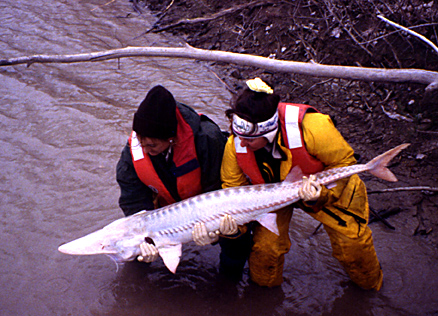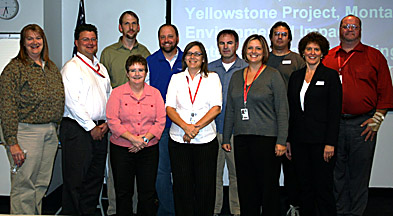| Partnering for Pallid
Passage
|
 |
By Becky Latka |
May 2009 |
A group of state and federal agencies, The Nature Conservancy, and the Lower Yellowstone Irrigation District are partnering to develop fish passage around the 100-year-old Intake Diversion Dam on the Yellowstone River in Montana. The primary reason for this unique effort is to help the endangered pallid sturgeon (Scaphirhynchus albus) access spawning habitat upstream from the dam.
A hatchery-raised pallid sturgeon is released into a wild environment. Photo courtesy of U.S. Geological Survey.
The pallid sturgeon is a living representative from the dinosaur age. Their oldest known ancestors are from the Cretaceous period. This large cartilaginous fish has survived ice ages, but now it is threatened with extinction. Pallid sturgeon are larger than the related shovelnose sturgeon (Scaphirhynchus platorhynchus). Adult pallid sturgeon weigh15-80 pounds and can live for more than 50 years, with some individuals surviving for 100 years (see sidebar below). The pallid is highly migrational, with seasonal movements of hundreds of miles when not impeded by man-made structures. The construction of major dams along the Missouri River in the 1940s and 50s segmented the population, impeding migration and successful spawning and recruitment of young pallids. Other impediments include the locks and dams on the Mississippi River and irrigation diversion dams on the Yellowstone River. In addition to blocked migration routes, this large fish was also commercially harvested in the past.
When the pallid sturgeon was listed as endangered in 1990, federal agencies were required under the Endangered Species Act to consult with the U.S. Fish and Wildlife Service (Service) about ongoing operations of projects under their jurisdiction. As a result of ongoing consultation, two federal agencies have identified responsibilities to aid in the recovery of pallid sturgeon. The U.S. Army Corps of Engineers (Corps) operates the Missouri River main stem dams, and the Bureau of Reclamation (Reclamation) owns the Intake Diversion Dam on the Yellowstone River—both important migration routes for pallid sturgeon. The Corps and Reclamation, along with the Service, Montana state agencies, The Nature Conservancy, and the Lower Yellowstone Irrigation District signed a Memorandum of Agreement to work together on development of fish passage around the 100-year-old Intake Diversion Dam.
Passage around Intake Diversion Dam is a high priority task in the Service’s 1993 Recovery Plan for pallid sturgeon, and is also recommended by the Upper Basin Pallid Sturgeon Recovery Workgroup (see sidebar left). This fall, a team consisting of Corps and Reclamation staff began the National Environmental Policy Act (NEPA) process to evaluate alternative ways to get pallid sturgeon and other native fish past the dam so they can access another 165 miles of the Yellowstone River and its tributaries upriver from the dam. Public scoping meetings were held in Montana in order to gather comments and to solicit other ideas on providing fish passage. A key local issue is maintenance of irrigation, valued at $25-30 million annually. The NEPA document will be available for public, agency, and Tribal review when released in late 2009. After finalization of the NEPA process, the Corps intends to fund the construction of the selected alternative. Time is running out for the pallid sturgeon, since some biologists anticipate that the wild pallids may be extirpated from Montana by 2017. After the wild pallids are gone, only hatchery-raised pallid sturgeon will reside in the Yellowstone. Although other recovery actions are ongoing in other river reaches, the recovery of the upper basin pallid sturgeon is especially important since few of these fish have hybridized with the related shovelnose sturgeon, as is the case in the lower Missouri and Mississippi Rivers. The lack of hybridization is thought to be an indicator of high-level habitat quality within the Yellowstone River. Unlike the Missouri River, the Yellowstone River has a relatively natural hydrograph (river discharge over time) and temperature profile, and offers the best locale for conservation of wild pallid sturgeon. Although fish passage projects have been constructed elsewhere for lake sturgeon and have been incidentally used by green sturgeon and white sturgeon, this will be the first fish passage project specifically for the endangered pallid sturgeon.
The Nepa team after a public scoping meeting. The author is front and center of the group, in a white shirt.
The NEPA team will work together over the next two years, along with other partners, to ensure that the selected management alternative meets the needs of the pallid sturgeon and other river resource users, including irrigators. For more information on this project, visit http://www.usbr.gov/gp/mtao and click on “Lower Yellowstone River.”
Becky Latka has worked as an Environmental Resource Specialist for the Omaha District Corps of Engineers, Planning Branch, since 1991. She works on projects in the Missouri River and Yellowstone River drainages, specializing in Endangered Species, NEPA compliance, fisheries biology, and fish passage.
|
|



